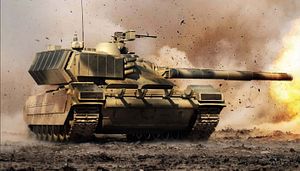A U.K. Ministry of Defense (MOD) internal briefing paper has issued a warning over the Russian military’s third-generation T-14 main battle tank (MBT), an armored vehicle based on the “Armata” universal chassis system, according to a leaked document obtained by The Telegraph.
“Without hyperbole, Armata represents the most revolutionary step change in tank design in the last half century,” the report, written by a senior Army intelligence officer, reads. “As a complete package, Armata certainly deserves its billing as the most revolutionary tank in a generation.”
“For the first time, a fully automated, digitized, unmanned turret has been incorporated into a main battle tank. And for the first time a tank crew is embedded within an armored capsule in the hull front.” The report emphasizes that it should “not be interpreted as an official MoD statement.”
The Armata is the first new MBT developed by Russia after the collapse of the Soviet Union.In September, the Russian MOD has concluded a contract with Uralvagonzavod (UVZ), the world’s largest tank maker, for the first batch of 100 T-14 Armatas. Russia plans to around 2,300 T-14s by 2025. (The U.K. intelligence report, however, points out that Russia is only capable of building 120 new Armata tanks per year from 2018. Even that number might be too high though.)
The days of an AH-64 Apache gunship taking out a Russian-made tank from a safe distance might be over. The Armata allegedly is one of the first MBTs to be designed from the outset with an active protection system. As I explained elsewhere (See: “Russia’s Military to Receive 100 New T-14 Armata Battle Tanks”):
Russia’s new MBT features an unmanned turret and will eventually be a completely automated combat vehicle that can be remotely controlled. (…) [T]he T-14 will feature a number of technological innovations, including new ultraviolet (UV) detectors as part of the Armata’s active defense system to protect it from incoming enemy fire.
Among other things, the Armata reportedly boasts a new generation of explosive reactive armor (ERA), according to a Russian defense industry source: “The new ERA can resist anti-tank gun shells adopted by NATO countries, including the state-of-the-art APFSDS DM53 and DM63 developed by Rheinmetall [and] anti-tank ground missiles with high-explosive anti-tank warheads.”
The Armata’s main weapon is the 2A82 125-millimeter smoothbore cannon, capable of firing high-powered munitions (10 shots a minute at an effective range of up to 7 kilometers). “The 125-millimeter variant may be replaced with a more powerful 152-millimeter cannon in later versions, although this would reduce the T-14s ammunition capacity and likely require a complete re-design of the platform,” as I noted elsewhere. Additional weapons include a 30 mm sub-caliber ranging gun, as well as a 12.5 mm turret-mounted heavy machine gun reportedly capable of taking out incoming projectiles approaching at speeds of up to 3,000 meters per second.
The British intelligence report also points out that Russia is currently working on “adding six additional armored vehicles to the stable.” As I noted elsewhere, the Armata universal chassis system will eventually serve as platform for over a dozen different tracked vehicles, including a self-propelled artillery gun, an armored military engineering vehicle, and an armored personal carrier. “70 percent of tracked armored vehicles of the Russian Ground Forces are slated to be replaced by vehicles based on the Armata universal,” I explained. The question remains whether Russia will be able to afford this major modernization push of its armored forces. As of now, it seems more than unlikely.

































